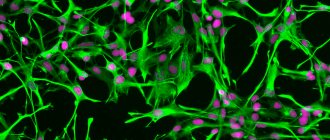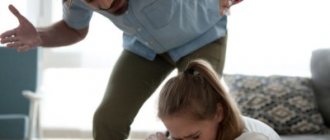Inexorable age often leads an elderly person to the point where it becomes very difficult to live independently, cope with everyday problems and needs, and then relatives take care of him. When a grandmother or grandfather feels relatively well, but sometimes gets bored, complains about life and is capricious, this is a good scenario. In such cases, relatives often cope independently with his care and treatment at home. Quite often, during the holidays or vacations of children and grandchildren, older people themselves are happy to go to specialized boarding houses, because the peace of loved ones and communication with peers is an important condition for their mental health and spiritual harmony.
The situation is much more complicated when symptoms of dementia appear in older people, and even more so when senile dementia enters the asocial stage of its development, preventing normal communication with a recently sane loved one. Unfortunately, every 12th person on the planet over 70 years of age has some degree of cognitive impairment. Moreover, the number of such people has doubled since 2003, it is believed that this is due to improved diagnostic methods and increased life expectancy. The statistics are inexorable: by 2050, the number of dementia patients will grow to one hundred million people (compare: now there are 44 million), which means that in the near future, each of us may actually face a similar problem.
Blurring boundaries
One of the main features of the human brain is the desire to classify, divide objects into groups and assign names to them. Every new phenomenon or event, every new person must receive its own name. Everything should have a place on the shelves in our heads. Our love for discrete (clearly separated) concepts comes from this feature. There are apples and there are pears. No pear apples with a ratio of 40 to 60 respectively. Our brain loves clarity, and we obediently follow it, dividing the phenomena of the external and internal world into clear categories. At first, such an approach significantly simplifies cognition and creates a solid foundation for understanding what is happening around us. Imagine what traditional biology would be like without this discrete approach. We would not have classes, families, groups and species and many other names that reflect our species' love of division and classification. How would we exist in such a chaotic world?
The irony is that classifications change over time. Linnaean systematics changed quite a lot under the influence of new biological discoveries, and scientists have repeatedly agreed on how to divide living organisms in accordance with their structure, genetic data or other characteristics. This state of affairs does not mean that all classifications are false. It only tells us that classification is a human tool applicable to objects in the living world. Sorting biological objects into groups is a difficult task.
A much more flexible approach that better reflects reality would be to understand that, despite the discreteness of the categories, we are dealing with a continuum. Of course, there is no continuum between chickens and lizards in real time (chicken lizards and lizards), but there is a continuum of many creatures between lizards now and their ancestors. Here we are talking about an evolutionary process, where changes accumulate gradually; they are small and unnoticeable. They change the body gradually, over hundreds and thousands of years. Fossil forms are not always preserved, and we do not see the entire process. Each ancestor found creates two empty spaces around itself that require filling. We take a discrete approach to the continuum of states and sometimes get controversial and disappointing conclusions. This shouldn't surprise us. Our discrete instrumentation is good, but not ideal for continuum.
What was this conversation about evolution and classification? It was important for us to dive into biological categories, because health and illness, which I will discuss further, are the same biological categories. This is an attempt to describe the states of a living organism (in particular, a person). This is the same discrete instrumentation that is applied to the continuum of states. Many diseases are slow-moving events, which in some sense are similar to speciation. Of course, there are situations in which the disease develops rapidly (injuries, myocardial infarction), but even they can be considered from these positions. For example, we can consider myocardial infarction as a consequence of long-term developing atherosclerosis, and recovery from injury is also a slow process, a movement from illness to health. The approach I describe is not exhaustive, but it does provide some insight into medicine, health, and illness.
Health and illness are discrete concepts superimposed on a continuum of states. In the biological world, neither one nor the other exists. The concept of disease and the concept of health are human inventions. An illness is something that people agree upon as an illness. People got together and decided that this condition is now a disease, but this is no longer a disease. We have released a new international classification of diseases, 11th revision (ICD-11), and the principle there was the same. If you think this is a strange approach, then it works in many areas of human knowledge, and we actively use it there.
Of course, there are conditions that each of us clearly defines as loss of health - for example, a fracture, loss of a limb or one of the senses. Such simplicity and intuitiveness is determined by the fact that changes in the human condition are easily noticeable and do not require additional confirmation - in a laboratory or some other method. Much more questions are raised by processes that are invisible to the eye or carry a subjective assessment. Anemia caused by a lack of iron in the diet would be a good example. It cannot be determined by eye when it comes to a mild degree, but according to tests it is detected quickly, literally in a few hours. So does it exist if we, ordinary people, don’t consider it as such? Another example is dementia. Declining memory and other cognitive abilities are often considered normal for older people, but disease experts don't think so. If the relatives of an elderly person with Alzheimer's dementia do not consider him sick, this does not mean that he is. Here we come across the fact that there are experts who have specialized knowledge in the field of medicine. They decide whether a person has a disease or not, placing him in one of two groups - healthy or sick. Doctors are such experts. They have the important responsibility of drawing the line between health and illness and placing people on both sides of it. This is a difficult task because in reality there is no boundary in a biological sense (Fig. 1).
Figure 1. Diseases as biological conditions are not clearly separated states, but many different forms , between which it is sometimes difficult to draw a clear line. Likewise, it can be difficult to draw the line between health and illness.
Drugs for dementia in the elderly after stroke
If a person has insufficient blood flow chronically, then dementia develops slowly. But in the case of a stroke, dementia can occur suddenly and immediately. The danger is precisely bleeding in the part of the brain that is responsible for mental function. There may be isolated signs of deterioration in brain function, but this will not be dementia. But when the disorders form a whole complex, we need to talk about mental degradation due to a stroke.
Symptoms of post-stroke dementia:
- persistent memory impairment;
- uncertain, unsteady gait;
- the presence of obvious signs of neuralgia;
- loss of counting ability;
- difficulty speaking and reading;
- inadequate thinking;
- difficulty in analysis;
- depression;
- a person is lost as a person;
- inability to use knowledge.
In such a situation, it is necessary to use medications of different groups:
- psychostimulants - trigger the protective functions of the central nervous system (caffeine, Mesocarb);
- nootropics - activate the brain, improve memory (Piracetam, Oxycytam);
- glutamic acid, Cavinton - improve metabolism and blood supply to the brain;
- Arbiflex, Curantil - improve cerebral circulation;
- complex of vitamins;
- Mezapam, Phenazepam - drown out fear and melancholy.
An infinite number of the most “beautiful” forms
Now is the time to expand our reasoning. We have pointed out that health and illness are not simply discrete categories, but rather a spectrum of states with no clear transition when viewed as biological entities. I think it is worth adding arguments in favor of this idea and highlighting the problem from different angles.
When we talk about the transition between health and disease, and the reverse movement, we understand that the path to disease consists of many small steps - minimal changes in the tissues of our body. These are mutations, immune processes, cell growth or death, accumulation of unnecessary substances or increased consumption of necessary ones. At some point, the changes become so significant that symptoms, laboratory changes, or changes visible on ultrasound or MRI appear, and from that point on we record the disease. But when did it start? Did it begin with the first mutation in the future cancer cell or with the first dying cardiomyocyte? This question is often meaningless in practice, but for our reasoning it is of great importance.
In large studies, doctors and scientists have discovered various features that increase the risk of developing the disease. These features have been called risk factors. Smoking, high cholesterol, and low physical activity are risk factors for cardiovascular disease. For many diseases, such risk factors can be found. For schizophrenia, for example, this would be the use of cannabinoids. This tarnishes marijuana's reputation as a "safe" drug. However, individual substances in marijuana are still used as medicines [1], and psychedelic therapy is gaining popularity among researchers [2]. The identification of risk factors and other research have created a world where, in addition to health and disease, there are also pre-disease conditions. This concept better reflects a continuum of states than two discrete categories. For example, in patients with schizophrenia, cognitive impairments are described that precede the development of psychosis itself, and in Alzheimer's disease, beta-amyloid begins to be deposited before the first symptoms of dementia appear. The disease doesn’t seem to exist yet, but it already lives in our body.
An additional difficulty is that often such signs are probabilistic, and it is not possible to strictly link them with the development of the disease. There are rarer examples in which what exists before the symptoms definitely points to the development of the disease in the future. In Huntington's chorea, one mutation determines whether you get the disease or not. If you are a carrier of this mutation, then there are no options - the disease will develop unless you die before the age of its onset. Does a carrier of this mutation suffer from Huntington's chorea? Biological research in medicine has shown us the complexity of such issues. We saw that everything is not as simple as we thought. We saw how things are in reality.
Another side of the problem of distinguishing between illness and health is the understanding that illness of one organ does not mean illness of the whole body. Let's say I have gastritis - am I sick or healthy? But it’s just the stomach, not the whole body. It turns out that there is more healthy in me than sick. This means I am more healthy than sick. These are strange thoughts, but they are relevant in the context of the continuum of health and illness. There are processes that affect us more than others. Advanced stomach cancer affects us more seriously than the flu. Both are diseases, but one of them is more “healthy” than the other. However, we have not yet touched deeply on the topic of self-perception. Am I really sick if I don’t consider myself sick? How do I react to my illness? And—in the case of a mental disorder—where do we draw the line between the normal me and my illness? These questions are complex and unlikely to have a clear and definitive answer, but their formulation and discussion are important for the development of medicine.
How to treat?
As mentioned above, it is impossible to completely cure dementia. However, in the early stages it can be controlled and not allowed to develop, so that the last years and even decades of the elderly person’s life can pass comfortably.
If dementia has not progressed to an advanced stage, treatment is carried out at home. For atrophic dementia, the doctor may prescribe medications:
- acetylcholinesterase inhibitors to eliminate the deficiency of neurotransmitter hormones;
- glutamate receptor inhibitors to neutralize glutamate, which damages nerve cells;
- antidepressants to eliminate feelings of depression and improve mood;
- antipsychotics for delusions and hallucinations.
For vascular dementia:
- antihypertensive medications for hypertension;
- corticosteroids for autoimmune and cerebral diseases;
- interferons and immunomodulators for multiple sclerosis;
- aspirin and other anticoagulants to thin the blood;
- herbal preparation ginkgo biloba to normalize vascular function;
- B vitamins to normalize blood flow to the brain;
- gliatilin and other antidepressants and nootropics.
All these drugs keep neurons in working condition and prevent the destruction of nerve connections. Since each of them can have side effects, only a doctor prescribes them.
However, drug intervention alone is not enough. It must be accompanied by other measures.
- Communication – first of all with friends and loved ones. Healthy, positive interaction with people who are always ready to support evokes positive emotions, improves mood, and increases the tone of the whole body.
- Physical exercise. Age and general health are taken into account. These could be, for example, exercises to train coordination and fine motor skills.
- Psychological trainings. Sessions with a professional psychologist can help as well as regular pleasant communication.
- Physiotherapeutic sessions. Electrical stimulation under the supervision of a specialist helps improve the condition of a problematic nervous system.
- Proper nutrition. Meat, fruits, vegetables, grains - everything should be in the right proportions. Your doctor or nutritionist will advise you on how to eat.
- Getting rid of bad habits. In order not to aggravate the situation, it is highly advisable to quit alcohol and smoking.
It is necessary to monitor the patient’s overall health - monitor blood pressure, check cholesterol and blood sugar levels.
“The future belongs to preventive medicine”
The development of medical science and the expansion of knowledge about our body, healthy or sick, leads to the fact that medicine penetrates more and more into everyday life. We can cautiously call this process the medicalization of everyday life. An illustrative example of the medicalization of everyday life was the coronavirus epidemic [3], which began at the end of 2021 and continues to this day. Medical procedures have begun to permeate our daily rituals, and conversations about the coronavirus vaccine and treatment have become as commonplace as sharing recipes or discussing politics. Medicine penetrates deeper into our lives than we think. It is not limited to the clinic door and the hospital emergency room. 2021 has shown us how much medical problems can change in our lives - private and public (Fig. 2).
Figure 2. In 2021, we all find ourselves in a new world where there is a coronavirus pandemic. Many of us were very active in discussing a variety of medical issues, such as the need to wear masks.
Myths about Masks and Other Coronavirus Facial Coverings
Historically, doctors dealt with sick people and diseases. The doctor rarely visited a healthy person or vice versa. Contact with a patient occurred when the patient developed symptoms or was concerned about their own health. This almost inevitable negative emotional context of communication with a doctor is an important feature of medical communication. Over time, medical knowledge has significantly changed the world around us, and medicine no longer serves as a tool solely for survival. People began to develop a demand for maintaining health, and not for restoring it. Over time, medicine for the sick began to be supplemented by medicine for the healthy. Traditional medical education focuses on treating disease and restoring health, rather than preserving it. The preventive component in professional medical practice is poorly developed. I think that people do not always understand why they need to go to a doctor for information about maintaining health, because he deals with sick people, not healthy ones.
The result of the discrepancy between the activities of doctors and the demands of people was the appearance in this field of people without special medical education. Bloggers and coaches tell people about a healthy lifestyle, based on publicly available scientific information. It cannot be said that all of them are telling lies or causing harm, but the level of expertise and responsibility for their words among this group of people is usually low. Why should people get a medical education when there is PubMed, Google Scholar, Instagram and TikTok? Although, judging by the quality of the content, for many authors, reading scientific articles and analyzing them for their own audience still remains a prohibitively difficult task.
Of course, there is nothing wrong with people’s interest in maintaining their health. The state, with a reasonable approach, should also have an interest in preserving the health of its citizens. A common theme in discussions of the impact of any disease in scientific research is the economic loss from disability and mortality associated with this disease. Caring for people's health is a long-term investment by the state or a private company, as well as a competitive advantage over other players in this field. This is where the importance of preventive medicine lies. Some diseases are easier and cheaper to prevent than to treat. This is also true for mental disorders.
About types of prevention
Before we get acquainted with the features of prevention of mental disorders, we should better understand what prevention is. Prevention is a set of measures aimed at preventing injuries and diseases. A good example of a preventive measure would be vaccinations - medical interventions that annually save hundreds and thousands of lives of people around the world (read the special project on vaccination on Biomolecule). It should be understood that preventive measures can reduce the risk of a negative event, but do not completely eliminate it.
There are usually two types of prevention:
- Primary prevention is action directed against the occurrence and exposure of a person to risk factors for diseases and injuries. In the case of primary prevention, we try not to create opportunities for harm to health. Primary prevention measures are varied and are implemented at the personal level and at the level of large communities. Hand washing, legal speed limits on roads, safe sex practices and food hygiene are all primary prevention measures.
- Secondary prevention prevents the transition of the asymptomatic course of the disease to clinical manifestations. Secondary prevention includes regular medical supervision of patients from risk groups and changes in lifestyle for representatives of these groups. If we detect a person has high cholesterol levels, but there are no symptoms of coronary heart disease or other atherosclerotic vascular disease, then interventions at this stage will be secondary prevention. This may include diet, increased physical activity and/or medication. As with primary prevention, secondary prevention is largely a matter of changing the lifestyle of a person at risk of developing the disease. Preventing repeated deterioration of the patient's condition with the help of drug therapy can also be classified as secondary prevention.
The famous statement of Nikolai Ivanovich Pirogov, used as the title for this chapter, reveals the direction in the future development of medicine. We have been actively researching mental disorders and other illnesses. Much, although not everything, became clear to us about our illnesses. The time has come to put this knowledge into practical use.
Preventive measures for healthy people usually involve lifestyle changes. They focus on human behavior. These measures help prevent negative events or instill in people the habit of protective actions. Wearing medical masks was and remains an unusual ritual for us, but for China it is a common measure that did not have to be adapted to during the epidemic of the new coronavirus. Preventive medicine is closely related to public health. Sometimes the norms of preventive medicine require enshrinement at the legislative level, and this is a fair decision. We cannot allow people who are carriers of intestinal infections into food production to prevent the emergence of another Typhoid Mary.
An example of a preventative mental health intervention that focuses on behavior would be limiting access to highly toxic pesticides in Asia. Suicide in rural areas in Asia is a serious social and health problem [4]. The number of deaths in this region of the planet caused by self-poisoning with pesticides amounts to thousands of people per year. One of the reasons is the easy availability of highly toxic pesticides to farmers. As researchers of this problem note, farmer suicides using pesticides are usually impulsive. This means that limiting access to pesticides could theoretically reduce the number of pesticide victims. A ban on the storage and use of highly toxic pesticides has reduced mortality from this cause in agricultural areas of Asia. In India, for example, special centralized storage facilities for pesticides were installed, which made it difficult for those who might use them as a means of self-poisoning to quickly access them.
What should relatives do? Benefits of going to a nursing home for people with dementia
Unfortunately, the disease will inevitably progress. Relatives will find it increasingly difficult to cope with this and will experience great stress as they watch their loved one’s personality gradually disintegrate. In addition, the need to look after a patient 24/7 takes a lot of time and effort. You don't have to bear this burden yourself. The Hearts of Generations network of boarding houses for the elderly accepts patients with dementia. For guests there are:
- Daily health check;
- Constant supervision by professionals;
- Six meals a day;
- 24/7 care;
- Comfortable rooms;
- Monitoring the treatment prescribed by the doctor.
“Hearts of Generations” is located in a picturesque place with clean air, away from the bustle of the city, which has a positive effect on the health of the guests. You can find out more detailed information or leave a request on the website, indicating contact information for feedback.
For help, you can always contact our boarding house for the elderly, where we can help you.
It's easier to prevent than to cure
Dementia remains a medical condition that currently has no pathogenetic treatment. We cannot influence the cause of the disorder and significantly change the course with the help of the drugs we have. Because of this, it is wise to focus on dementia prevention to reduce the incidence of this disease. An equally reasonable solution would be screening in risk groups, which will identify patients with varying levels of cognitive decline. This approach requires training of professionals and changes in attitudes and alertness towards cognitive impairment. Memory loss and other cognitive impairments are not a feature of old age, but a medical and social problem that requires intervention. Ignoring it is a very short-sighted decision that we cannot afford in the face of a gradually aging global population.
Senile dementia. Symptoms and signs
Age-related dementia can manifest itself in the following ways:
- difficulty concentrating;
- slow reaction, general lethargy;
- memory impairment;
- decreased social activity;
- loss of interest in favorite activities;
- sloppiness;
- voice distortion (unusual articulation, different timbre);
- changes in gait (unsteady, mincing, so-called “ski”);
- intolerance, aggression, suspicion;
- problems with swallowing;
- narrowing the range of gestures;
- narrowing of the facial range;
- depressed mood, depression;
- sharp transitions from joy to sadness;
- drowsiness;
- shifts in wakefulness and sleep cycles;
- dizziness, fainting;
- hallucinations;
- epileptic seizures;
- urinary and fecal incontinence;
- lack of control over behavior.
The severity and intensity of symptoms depends on the individual parameters of the patient, concomitant diseases, which part of the brain is affected and what the area of the lesion is, as well as many other conditions. In the later stages of the disease, the patient’s personality disintegrates, he degrades, everyday skills are lost almost completely, and there is no orientation in time, as well as in space.
Non-drug treatment
In addition to medications, a patient with senile dementia may benefit from:
- Cognitive trainings that involve reading books together, reproducing them, and discussing them. Elderly patients memorize poems and study using special cards. It is important to practice daily, as there is a chance that everything you learn will be quickly forgotten.
- Biographical trainings, the purpose of which is to maintain memories that are erased from memory. During these classes, events that happened in the past are discussed, old photographs are viewed, and retro music is listened to.
- Keeping a diary in which events are recorded. It helps train thinking, helps relieve excessive emotional tension and eliminate negative experiences.
- Physical activity, including sets of exercises, as well as walks in the fresh air.
- Art therapy, music therapy, pet therapy aimed at solving educational, developmental and therapeutic problems.
Risk factors and at what age can you get sick?
The risk of developing dementia at the age of 60-65 years is 10%. The indicator increases significantly after 80-85 years (30%). It's not just aging that can lead to dementia. The disease can affect both older and younger people. Pathology can appear at 40-45 years of age. The reason for this is hereditary predisposition, the presence of mutations of certain genes, traumatic brain injuries and the negative impact of the environment. If a person works in the chemical industry and comes into contact with toxic substances and pesticides, then the likelihood of getting sick increases significantly. Treatment of dementia in young people will be effective if the problem is detected in time and consulted with a specialist.
How to prevent the development of dementia?
Having a family history or working in hazardous industries makes you think about preventing a terrible disease. Throughout your life, you should exercise regularly, maintain active brain activity, maintain a healthy lifestyle, eat varied and healthy foods, maintain a healthy heart and blood vessels, prevent the development of diabetes and obesity, and monitor your blood pressure (it should not be elevated).











